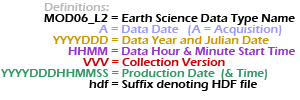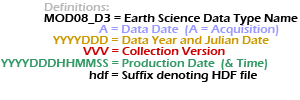 |



|
Tracking of known problems and subsequent fixes is an important issue for MODIS data users.
This page will act as a repository of all known MODIS Atmosphere Data Product problems,
as well as how to determine the problematic version (and the fixed version) of the HDF data --
therefore data users should check this page for updates regularly.
Data Users unfamiliar with how to properly track problems and fixes by determining the version of their downloaded HDF files
should refer to the documentation at the bottom of this page.
|
|
|
Collection 006 Issues
Click the colored buttons below for the known problems associated with each MODIS Atmosphere Data Product in Collection 6.










- Incorrect Terra IR Water Vapor Profiles (in MOD07 and copied to MOD05) from Band 27 Crosstalk
 Description: April 2016 update from PGE03 developers: A band 27 cross-talk problem, that increased (and became more pronounced) over time starting around 2010, produced incorrect IR Water Vapor profiles, with artificially low moisture content in the middle atmospheric layer and excessively high values in the upper troposphere. The MCST is still investigating possible fixes for this problem.
The IR Water Vapor profile data is in an SDS called "Water_Vapor_Infrared" in the 05_L2 file. Note that the "Water_Vapor_Near_Infrared" SDS (which is only in the 05_L2 file) is not affected.
Description: April 2016 update from PGE03 developers: A band 27 cross-talk problem, that increased (and became more pronounced) over time starting around 2010, produced incorrect IR Water Vapor profiles, with artificially low moisture content in the middle atmospheric layer and excessively high values in the upper troposphere. The MCST is still investigating possible fixes for this problem.
The IR Water Vapor profile data is in an SDS called "Water_Vapor_Infrared" in the 05_L2 file. Note that the "Water_Vapor_Near_Infrared" SDS (which is only in the 05_L2 file) is not affected.
Impact: High
Data Dates Affected: 2010 and on (but worse 2014 and on)
Platform Affected: Terra Only
|

|
|

|
|
PGE Version
|
Production Dates
|
|
PGE Version
|
Production Dates
|
|
|
≥ 2010
|
|
Not Corrected
|
Not Corrected
|
Bad Near-Infrared (NIR) Water Vapor Data
 Description: There was a problem in the Near IR (NIR) Water Vapor Product in Collection 006 related to the use of re-aggregated L1B as input.
The solution was to use the original non-aggregated L1B and reprocess the entire Aqua data record.
Description: There was a problem in the Near IR (NIR) Water Vapor Product in Collection 006 related to the use of re-aggregated L1B as input.
The solution was to use the original non-aggregated L1B and reprocess the entire Aqua data record.
Impact: High
Data Dates Affected: 7/2002-7/2014
Platform Affected: Aqua Only
|

|
|

|
|
PGE Version
|
Production Dates
|
|
PGE Version
|
Production Dates
|
|
≤ PGE04 v6.0.37
|
≤ 2014 191 (7/10/2014)
|
|
≥ PGE04 v6.0.38
|
≥ 2014 195 (7/14/2014)
|
Suspect Infrared (IR) Water Vapor Data at Night
 Description: It should noted that the Infrared (IR) Water Vapor Data is copied from 07_L2 into 05_L2.
There was a problem in the Collection 6 (C6) Atmosphere Profile Product (07_L2) for nighttime data only.
In the nighttime (07_L2) granules, an error occurred in selecting the proper GDAS (NCEP 1-Degree Global Data Assimilation Model) re-analyses ancillary data file.
Instead of selecting the file closest in time with a less than 3 hour time differences between the GDAS time and the granule time,
the algorithm selected the wrong GDAS file time resulting in as much as a 6 hour time difference.
The 07_L2 algorithm uses the surface pressure variable of the GDAS reanalyses to determine the lowest level of the atmospheric temperature,
moisture, and ozone profiles. To set the lowest level as accurate as possible is very important for integrating the water vapor content of the column and
the layer mean of water vapor close to the surface.
The error affected the 07 L2 SDS's "Water_Vapor" and "Water_Vapor_Low". The values were just "marginally off" but affected all granules globally.
Since the Infrared (IR) Water Vapor Data data is copied from 07_L2 into 05_L2 HDF files, both the 05_L2 and 07_L2 HDF data products were affected.
Description: It should noted that the Infrared (IR) Water Vapor Data is copied from 07_L2 into 05_L2.
There was a problem in the Collection 6 (C6) Atmosphere Profile Product (07_L2) for nighttime data only.
In the nighttime (07_L2) granules, an error occurred in selecting the proper GDAS (NCEP 1-Degree Global Data Assimilation Model) re-analyses ancillary data file.
Instead of selecting the file closest in time with a less than 3 hour time differences between the GDAS time and the granule time,
the algorithm selected the wrong GDAS file time resulting in as much as a 6 hour time difference.
The 07_L2 algorithm uses the surface pressure variable of the GDAS reanalyses to determine the lowest level of the atmospheric temperature,
moisture, and ozone profiles. To set the lowest level as accurate as possible is very important for integrating the water vapor content of the column and
the layer mean of water vapor close to the surface.
The error affected the 07 L2 SDS's "Water_Vapor" and "Water_Vapor_Low". The values were just "marginally off" but affected all granules globally.
Since the Infrared (IR) Water Vapor Data data is copied from 07_L2 into 05_L2 HDF files, both the 05_L2 and 07_L2 HDF data products were affected.
Impact: Moderate
Data Dates Affected: 7/2002-7/2014
Platform Affected: Aqua (Nighttime Granules) Only
|

|
|

|
|
PGE Version
|
Production Dates
|
|
PGE Version
|
Production Dates
|
|
≤ PGE03 v6.0.37
|
≤ 2014 191 (7/10/2014)
|
|
≥ PGE03 v6.0.38
|
≥ 2014 195 (7/14/2014)
|
Latest PGE Version Available (by Data Date)

How to Track MODIS Data File "Versions" (Important for Tracking Problems and Fixes)
Problems and fixes in MODIS Atmosphere Product HDF files can be tracked in one of two ways:
- the Product Generation Executive (PGE) Version Number that can be queried from any HDF file using the command:
ncdump -h *.hdf
- the HDF File "Production Date".
The HDF File "Production Date", which is the date the HDF file was actually generated or produced, can be found in the HDF filename itself (shown in green color below):
Level 2 Product Names:


|
Level 3 Product Names:


|
|
Note that 1.) all times are UTC time, not local time 2.) the DDD in the date denotes the Julian Date (001-366), and 3.) the MOD06_L2 (or MOD08_D3) prefix is only an example (MYD04_L2, MOD05_L2, MYD05_L2, MYD06_L2, etc. ... or MYD08_D3, MOD08_E3, MYD08_E3, MOD08_M3, MYD08_M3 could be substituted).
|
|